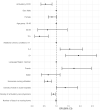Continuity of care and treatment intensity at the end of life in Swiss cancer patients
- PMID: 37029913
- PMCID: PMC10234661
- DOI: 10.1093/eurpub/ckad047
Continuity of care and treatment intensity at the end of life in Swiss cancer patients
Abstract
Background: Continuity of care (COC) was shown to be associated with fewer hospitalizations. We aimed to evaluate whether COC was associated with intensive intervention(s) at the end of life (IEOL), a preference-sensitive outcome, in cancer patients.
Methods: The study is based on claims data of patients with incident use of anti-neoplastics in Switzerland. COC Index, Usual Provider Continuity score, Sequential Continuity index and Modified Modified Continuity Index were calculated based on consultations with the usual ambulatory care physician. Treatment intensity was evaluated in the last 6 months of life, and COC was evaluated in months 18-6 before death in those who died between 24 and 54 months after incident cancer. IEOL comprised life-sustaining interventions (cardiac catheterization, cardiac assistance device implantation, pulmonary artery wedge monitoring, cardiopulmonary resuscitation/cardiac conversion, gastrostomy, blood transfusion, dialysis, mechanical ventilator utilization and intravenous antibiotics) and measures specifically used in cancer patients (last dose of chemotherapy ≤14 days of death, a new chemotherapy regimen starting <30 days before death, ≥1 emergency visit in the last month of life, ≥1 hospital admission or spending >14 days in hospital in the last month of life and death in an acute-care hospital).
Results: All COC scores were inversely associated with the occurrence of an IEOL, as were older age, homecare nursing utilization and density of ambulatory care physicians. For COC Index, odds ratio was 0.55 (95% confidence interval 0.37-0.83).
Conclusions: COC scores were consistently and inversely related to IEOL. The study supports efforts to improve COC for cancer patients at their end of life.
© The Author(s) 2023. Published by Oxford University Press on behalf of the European Public Health Association.
Figures
Similar articles
-
Continuity of care and receipt of aggressive end of life care among women dying of ovarian cancer.Gynecol Oncol. 2021 Jul;162(1):148-153. doi: 10.1016/j.ygyno.2021.04.024. Epub 2021 Apr 28. Gynecol Oncol. 2021. PMID: 33931242 Free PMC article.
-
Are family physician visits and continuity of care associated with acute care use at end-of-life? A population-based cohort study of homecare cancer patients.Palliat Med. 2014 Feb;28(2):176-83. doi: 10.1177/0269216313493125. Epub 2013 Jun 18. Palliat Med. 2014. PMID: 23779252
-
Assessing the application of continuity of care indices in the last year of life: a retrospective population-based study.Ann Fam Med. 2022 Apr 1;20(20 Suppl 1):2751. doi: 10.1370/afm.20.s1.2751. Ann Fam Med. 2022. PMID: 36696231 Free PMC article.
-
Continuity of outpatient care and avoidable hospitalization: a systematic review.Am J Manag Care. 2019 Apr 1;25(4):e126-e134. Am J Manag Care. 2019. PMID: 30986022
-
Continuity of care for acutely unwell older adults from nursing homes.Scand J Caring Sci. 2006 Jun;20(2):122-34. doi: 10.1111/j.1471-6712.2006.00388.x. Scand J Caring Sci. 2006. PMID: 16756517 Review.
References
-
- Menec V, Sirski M, Attawar D, Katz A.. Does continuity of care with a family physician reduce hospitalizations among older adults? J Health Serv Res Policy 2006;11:196–201. - PubMed
-
- Cheng S-H, Chen C-C, Hou Y-F.. A longitudinal examination of continuity of care and avoidable hospitalization: evidence from a universal coverage health care system. Arch Intern Med 2010;170:1671–7. - PubMed
-
- Almaawiy U, Pond GR, Sussman J, et al.Are family physician visits and continuity of care associated with acute care use at end-of-life? A population-based cohort study of homecare cancer patients. Palliat Med 2014;28:176–83. - PubMed
Publication types
MeSH terms
LinkOut - more resources
Full Text Sources
Medical


